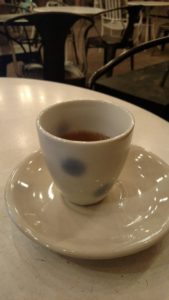In one of my outdoor education jobs we would rotate the classes we taught every week. So for a week straight, we’d teach the same class two or three times a day. There was a process of learning the class from a naturalist, teaching it, then being evaluated.
When I taught the aquatics class, we would take kids to the river catch little water bugs and let salamanders walk on our hands. At night I would have flashes of nets with nymphs in them, I could still feel the rubbery feet of the salamanders, hear the sound of the river, feel the wetness, and have images of green moss.
The museum class entailed a raptor center, taxidermy, and a room with snakes, hissing cockroaches and stick bugs that we’d take out for the children. Those weeks, in my half-conscious state I could feel the smooth skin of Sandy the boa constrictor, I’d get flashes of the inquisitive stares from Bob the American Kestrel, or the more awe inspiring stares of the peregrine falcon. I’d feel the spiny legs of the stick bugs and hissing cock roaches.
Through the process, I noticed how the class that I taught would have this effect of seeping into my being and would especially come out when I was half asleep at night or in the morning.
When I taught the geology class, my dreams and half-conscious flashes were of cliffs and rock formations.
The forestry class brought on flashes of leaves, bark, and pine needles with feelings of holding worms and rolly pollies from the worm bins.
Similarly, in my martial arts training, I’ve been working on keeping my thumbs in. Having a thumb sticking out while punching could easily end up in a sprained or broken thumb. I really like my thumbs so this one felt important to me. I started thinking about it all the time. I’d feel my thumb sticking out while driving or pointing at something and Id tuck it in. I started noticing it all the time. It felt tiring, having this periodic reminder of a body position I was trying to change. I started doing a lot of things with my thumbs attached to my pointer finger. I even started pointing at things with my middle finger. In my half asleep states I’d get the feeling of my thumb sticking out then tucking it back in.
They say that when you practice something new, you are building new neural pathways. Continued practice thickens the myelin sheath making the action more automated taking less thought to perform. Studies are even indicating that once something has been learned, you can thicken the myelin sheath (essentially practice) simply by thinking about doing the activity. Here’s a neat video about practice and mylanation.
I don’t completely understand the connection with sleep/sub consciousness, but it’s definitely there. Are we able to practice in our sleep? I feel like the intent of learning might affect the amount this happens. It also seems the myelination not only comes with practicing an activity but also building a relationship with interaction (knowing what salamanders little rubbery feet feel like)
In viewing life in terms of relationships, in seems that our relationships in the world build pathways and relationships in our brains and neural networks. On an experiential level, it feels like the sensations and correlations we have with these interactions seep into our being. Some actions speak to our sense of identity or meaning. They may calm us, agitate us, motivate or encourage us. Sewing, riding horses, doing dishes, driving in traffic, surfing, chewing on a pencil; I know people (myself included) that have nostalgic feelings about using outhouses. This means that even shitting in a hole has the ability to perform this magic of shooting electrical pulses through our brains and bodies making us feel alive and providing reference points for knowing ourselves and the world around us.
One way to explore this is to pay attention to some common actions; walking, sitting, scratching your nose, eating. Try to listen to the effects they have on your sensations, emotions, and attitude. Also, think about the relationship you have with that movement or activity. How many different states of being have you experienced while blowing your nose? Have you ever had a period of time where blowing your nose worked itself into your dreams?
Another way to explore this is to consider different experiences you’ve had that has left an imprint on your psyche. How have these experiences affected how you go about the world, especially in the subtle little ways. Going for a walk, picking a flower, going to a birthday party; everyone will have different images and feelings that come up when they hear the phrases for these actions.
For me, these practices have led to me wondering how much my relationships with varying parts of myself affect my relationships outside of me and vice versa. It seems like an endless feedback loop.



